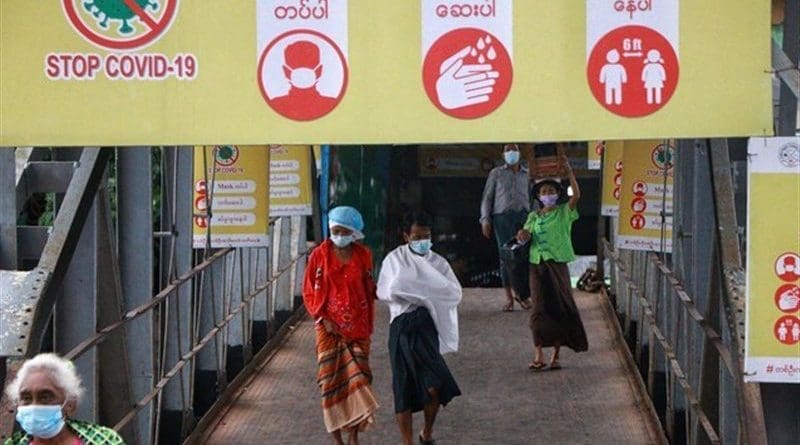The Myanmar Military’s Politicization Of COVID-19 – Analysis
By Moe Thuzar*
Despite the shortcomings of its healthcare system, Myanmar’s initial response to the COVID-19 pandemic seemed cautiously optimistic. The National League for Democracy (NLD) government sought epidemiological advice from world-renowned sources in February 2020, launching a Health Sector Contingency Plan and a COVID-19 Economic Relief Plan in April.
After the military coup in February 2021, Myanmar’s military (the Tatmadaw) officially recommitted itself to the NLD’s COVID-19 vaccination drive and associated economic recovery. Yet in reality the ruling military junta, known as the State Administration Council (SAC), focussed its attention and resources on suppressing anti-coup protests that sprang up nation-wide.
Some 70 medical personnel started the Civil Disobedience Movement (CDM) on 3 February in protest against the junta’s indifference towards pandemic hardship. The junta reacted by suspending, expelling and imprisoning CDM protestors. High treason charges were brought against Dr Htar Htar Lin, the former head of Myanmar’s COVID-19 vaccine rollout, after she joined the CDM.
Initially, COVID-19 infection and vaccination numbers were a secondary concern to many refusing to accept another spell of military rule. But with the emergence of the Delta variant reported COVID-19 infections rose sharply in mid-June, peaking at over 6000 daily new infections by mid-July. Myanmar’s Ministry of Health reports over 400,000 infections and over 16,000 COVID-19 deaths since 23 March.
In the weeks following the coup, quarantine and treatment centres in major cities continued to offer vaccinations as anti-coup protests and an aggressive crackdown against protestors took centre-stage. While safety measures including a fixed quarantine period and COVID-19 testing fell by the wayside, the junta forced schools and universities to restart in-person classes in June in a desperate attempt to assert control.
By mid-July, a third wave of infections became a ‘full-blown public health crisis’ in Yangon. Although the third wave affected cities and towns across the country, Yangon reported the highest incidence of cases. Daily deaths and cremations soared into the hundreds as public and private healthcare responses exposed the inadequacies and inequalities of the political system.
Households in need put out yellow flags to appeal for medical support. But when medical workers and community groups braved arrests to respond to people’s needs, the junta ambushed doctors, restricted oxygen supplies, builtmore crematoriums and imposed a nationwide lockdown as an extension of the July public holidays. The lockdown has since been extended but is largely disregarded due to business exigencies, weak enforcement and COVID-19 emergencies.
The military junta has politicised the pandemic, attempting to use its public health response as a means to justify its continued grip on the country. Its control of key medical inputs has caused the price of pharmaceuticals and medical equipment to soar, creating a black market for healthcare. The outbreak of COVID-19 in prisons only caught public attention when senior NLD official Nyan Win died after contracting COVID-19 in detention.
The SAC now views gaining access to vaccines as the best way out of the COVID-19 crisis, even if Myanmar’s vaccination rates are hampered by ongoing supply and logistical issues. The junta has turned to China and Russia for vaccine supplies, while indicating its desire to access the ASEAN COVID-19 Response Fund and produce vaccines locally under license.
While Myanmar expects to cover 20 per cent of its population with COVAX supplies, China has vaccinated ethnic armed organisations fighting the Tatmadaw. The country itself has administered about 3.5 million vaccine doses, around 3.2 per cent of the population. With an average of 5000 doses administered daily, the junta seems unlikely to fulfil its aim of vaccinating 50 per cent of the population by the end of 2021.
In multi-ethnic Myanmar, considerations about ‘who gets the vaccine first’ are another facet of the discourse surrounding equitable vaccine access. This has been further complicated by ongoing clashes between ethnic armed organisations and the military, with the Rohingya seemingly left out of the SAC inoculation drive. While Bangladesh started vaccinating Rohingyas in August, the Rakhine State rollout has ‘no current plans’ to vaccinate Rohingyas living in camps there.
The United Nations, the United States and the European Union have begun allocating humanitarian aid to meet Myanmar’s COVID-19 needs, but risk lending legitimacy to the junta. Regional organisations such as ASEAN, which emphasise engagement over recognition, face another challenge — implementing its Five-Point Consensus in the face of negative public sentiment.
The National Unity Government (NUG), representing the anti-coup movement in Myanmar, launched a COVID-19 Task Force in July to provide an alternative channel for coordinating with ethnic health organisations and international entities. The NUG’s Foreign Minister called on the international community not to ‘pick sides [and] engage both’ the SAC and the NUG.
Even as Myanmar’s third wave starts to stabilise, it constitutes one of the ‘confluence of crises’ in the country, not least the disastrous economic impact of the coup on lives and livelihoods. Weak health infrastructure, uneven governance capacity, and public communication challenges had already beset the NLD government. The coup compounded the collapse of the healthcare system, brought many households to the brink of poverty, and deepened the crisis of confidence in the country.
The devastation caused by the coup and COVID-19 will require decades of healing regardless of when Myanmar returns to its democratic transition. With multiple crises competing for global attention, the task of coordinating better international assistance as well as dealing with the crisis has become ASEAN’s main responsibility. As a first step towards rebuilding trust, ASEAN must ensure that humanitarian assistance reaches all communities in Myanmar. This takes on greater importance in light of the NUG’s recent announcement of armed resistance against the SAC.
*About the author: Moe Thuzar is Co-coordinator of the Myanmar Studies Programme at the ISEAS-Yusof Ishak Institute, Singapore.
Source: This article was published by East Asia Forum

